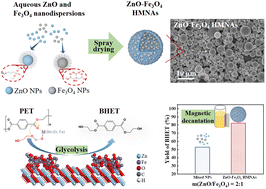Magnetic hollow micro-sized nanoaggregates for synergistically accelerating PET glycolysis†
Abstract
Polyethylene terephthalate (PET), as the most widely utilized polyester, causes global environmental problems due to its massive and durable accumulation in natural environments. The glycolysis of PET is an attractive alternative to mechanical recycling, but there remains a strong demand for efficient, convenient, and inexpensive catalysts. Herein, we present a spray-drying-assisted way to construct magnetic hollow micro-sized nanoaggregates (HMNAs) by assembling composite metal oxide nanoparticles to depolymerize PET synergistically. The as-prepared ZnO–Fe3O4 HMNAs completely depolymerized PET with a high monomer yield of 92.3% in a short period of 30 min at 190 °C, far above individual ZnO and Fe3O4 nanoparticles (NPs). The composite HMNAs can be magnetically separated in a few minutes and maintain a high activity for 5 cycles. DFT study reveals that the HMNAs effectively facilitated glycolysis by the high content of Lewis acid sites as well as the stronger adsorption between PET and the catalyst owing to the structural synergy effect of ZnO–Fe3O4 HMNAs. Furthermore, this spray drying strategy as a versatile and scalable methodology is extended to fabricate other HMNAs, exhibiting a similarly enhanced efficiency of glycolysis. The HMNAs are expected to open up avenues for the design of catalysts for upcycling of discarded plastics.



 Please wait while we load your content...
Please wait while we load your content...